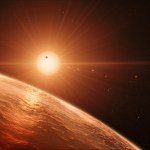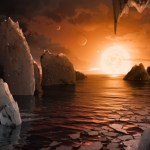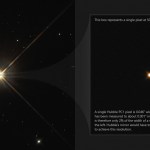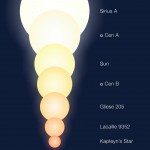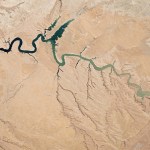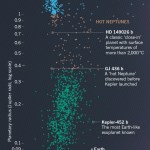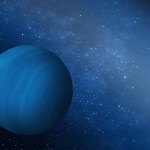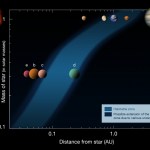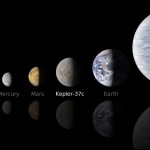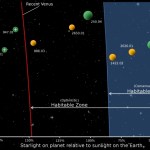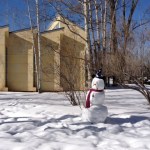Exoplanets
In February, exoplanet hunters announced the discovery of seven rocky planets orbiting a star called TRAPPIST-1 only forty light-years away. Compared to our sun, TRAPPIST-1 is tiny, and all its planets orbit closer than Mercury orbits Sol. But three of them are still in the Goldilocks zone that could be "just right" for life, and all seven planets could theoretically hold liquid water. While Ethan Siegel introduces the neighboring star system with spectacular illustrations from NASA and ESO, Greg Laden notes that the practice of saying these images are artistic interpretations "has…
As more and more exoplanets (at first) and earth-like exoplanets (eventually) have been discovered, the way thy are described to us has become increasingly sophisticated. Below are embeds of diverse video descriptions that have been very quickly developed and distributed given the freshness of this latest scientific discovery. Note that the practice of very clearly stating that a particular depiction of something that no human has ever seen, or will ever see, as being an artist's reconstruction has largely fallen by the wayside. Exoplanets are no longer physical features of the universe…
The European Southern Observatory made major headlines with their discovery of an Earth-like exoplanet orbiting our nearest neighboring star. On Dynamics of Cats, Steinn Sigurðsson writes: "ESO researchers, using the radial velocity variability technique, have detected a quite robust signature of a planet with a mass of 1.3 Earth masses, or more, in a 11 day orbit around Proxima Centauri." The planet is within the red dwarf's habitability zone, but we don't yet know if it harbors an atmosphere or liquid water. Greg Laden writes "now that we have an Earth-like planet in our sights, perhaps…
The Pale Red Dot project has found a planet.
It is a terrestrial planet, orbiting in the formal habitable zone of Proxima Centauri, the nearest star to the Solar System.
This wide-field image shows the Milky Way stretching across the southern sky. The beautiful Carina Nebula (NGC 3372) is seen at the right of the image glowing in red. It is within this spiral arm of our Milky Way that the bright star cluster NGC 3603 resides. At the centre of the image is the constellation of Crux (The Southern Cross). The bright yellow/white star at the left of the image is Alpha Centauri, in fact a system…
On Significant Figures, Peter Gleick explains that growing populations worldwide have exerted peak pressures on water supplies, leaving entire regions more vulnerable to natural variations in rainfall. In turn, global warming has made these natural variations more extreme. One such variation is El Niño, when "droughts are typically more widespread and severe." Dr. Gleick reports on the challenges faced around the world in 2016, as several historic droughts grow worse. Meanwhile, in honor of Earth Day, Ethan Siegel suggests we count our blessings: "there’s still no planet as friendly to life…
This month is the twentieth anniversary of the discovery of exoplanets, which are really just planets that are not in our solar system. (Frankly, I dislike the term exoplanet. It is so solarcentric.)
When you think about it, the discovery of planets outside our solar system (we need a word for that) is a special thing. On a graph of how expected and mundane a scientific discovery is vs. how exciting a scientific discovery is, these planets are distant outliers.
For years astronomers and cosmologists and others assumed that stars would generally have planets around them, or at least, this…
Big Eyed Beans from Venus - Captain Beefheart and his Magic Band!
Cool. Literally
Comparable to Mars in effective temperature, bit larger than Earth, probably slightly more massive than Earth (mean density could be lower), atmosphere unknown.
Might well have extensive surface regions with persistent liquid water.
Kepler-186f comparison
"Like all animals, human beings have always taken what they want from nature. But we are the rogue species. We are unique in our ability to use resources on a scale and at a speed that our fellow species can't." -Edward Burtynsky
It's really a romantic notion when you think about it: the heavens, the Milky Way, is lined with hundreds of billions of stars, each with their own unique and varied solar systems.
Image credit: 湖北直行便 of AstroArts, via http://www.astroarts.jp/photo-gallery/photo/13870.html.
But beyond that -- in addition to the stars -- there are hundreds of billions of planets…
“Next to reasoning, the greatest handicap to the optimum development of Man lies in the fact that this planet is just barely habitable. Its minimum temperatures are too low, and its maximum temperatures too high. Its day is not long enough, and its night is too long... These factors encourage depression, fear, war, and lack of vitality. They describe a planet, which is by no means perfectly devised for the nurturing or for the perpetuation of a higher intelligence.” -James Thurber
It's been just about three years, now, since the first announced discovery of a planet in another star system…
"You can spend too much time wondering which of identical twins is the more alike." -Robert Brault
You've of course heard by now the news that Kepler, the most successful and prolific planet-finding mission of all time, has probably reached the end of its useful lifespan.
Image credit: NASA / Kepler Mission / Wendy Stenzel.
With nearly 3,000 planet candidates under its belt, including many approximately Earth-sized (and some even smaller), and many within their parent star's habitable zone, we now know that, at least planet-wise, we're not alone in our galaxy.
Image credit: NASA Ames /…
The final session in the online discussion of the NASA Astrobiology Roadmap is today from 4-5 pm eastern.
Go to Astrobiology Future to sign in to the live web chat. Questions and comments will be taken both from call-ins and from written questions.
The online discussion will be moderated by Dr Francis McCubbin from UNM, Dr Sean Raymond from Laboratoire d'Astrophysique de Bordeaux, and yours truly...
The live session will, as with the other Roadmap sessions, be followed by a week long opportunity to input questions, ideas and topics for discussion at The Astrobiology Future Forum.
The four…
I have been remiss in not posting articles from the homepage here on Page 3.14...so to catch up, here's four at once.
No Beauty Without Water
On World Water Day, think of the water cycle that defines this planet. On The Pump Handle, Liz Borkowski writes "rivers often flow through multiple countries, and actions by one country or community can affect their neighbors’ ability to meet their water needs. Consuming too much water, or polluting a shared body of water, can make it hard for others to have enough for drinking, hygiene, agriculture, ecosystem health, and other needs." Rivers and…
Planets, planets everywhere
and on some there will be drops to drink.
An interesting confluence of research occurred over the last few months, leading to:
"A revised estimate of the occurrence rate of terrestrial planets in the habitable zones around Kepler M-dwarfs" by Ravi kumar Kopparapu PSU (arXiv), ApJLetters in press
Bottom line: about half of low mass stars in the Solar neighbourhood are estimated to have earth size planets in their habitable zone!
The implications are that habitable planets may be very common and the closest one within a few light years.
We'll know for sure very…
There were a number of interesting results reported today, the start of what promises to be an interesting week:
IR spectra of HR 8799 planets - Scharf at SciAm blogs reports on the Oppenheimer et al paper using the P1640 at the Palomar telescope.
Their interpretation of the rather low signal-to-noise low resolution spectra is that the outer two planets have little methane in their upper atmosphere and the inner planets do seem to have methane and that there is evidence for ammonia in the outer planets.
I suspect more data is needed.
HR8799 is an interesting system, I'm still not convinced…
The shadow of a shadow of a planet... and other fun Kepler discoveries
Exoplanets in Multi-body Systems in the Kepler Era is a conference currently under way at the Aspen Center for Physics
Physicists hard at work
The meeting is very vibrant, with a mostly very young crowd of active researchers.
There have been a number of very interesting talks reporting some very interesting discoveries, many of which are embargoed...
One, still unpublished discovery, from Josh Carter et al, for a KOI-not-to-be-named, used transit geometry from two planets and measurements of the stellar spin from…
"Stuff your eyes with wonder, live as if you'd drop dead in ten seconds. See the world. It's more fantastic than any dream made or paid for in factories." -Ray Bradbury
It wasn't all that long ago -- back when I was a boy -- that the only planets we knew of were the ones in our own Solar System. The rocky planets, our four gas giants, and the moons, asteroids, comets, and kuiper belt objects (which was only Pluto and Charon at the time) were all that we knew of.
Image credit: NASA's Solar System Exploration, http://solarsystem.nasa.gov/planets/index.cfm.
But these were just the worlds…
New research rethinks the possible prevalence of life in the Universe, suggesting that our asteroid belt—as disrupted by the gravitational influence of Jupiter—played a key role in seeding the Earth with water and organic compounds. Unable to coalesce, and situated around the solar system's "snow line," the belt provides millions of little ice trays which come smashing into the Earth on occasion. On Starts With a Bang, Ethan Siegel says "getting struck by asteroids can introduce new organics and materials into the ecosystem, and can knock off the apex animals of the time, paving the way for…
Schrödinger's Qu'ran - a 2012 thought experiment - in The Conversation, Matthew Bailes updates a classic paradox...
"...a physicist could extend this thought experiment to write a php script that would randomly download one of the Bible, Qur’an or even a classical quantum mechanics textbook to the iPad..."
On the Dispositive Null in the Literature - on an unrelated subject, the AstroWright expounds on a subtle issue.
Trendy Companions - more AstroWright
What do we want graduate school to be?
When do we want it?
Real Soon Now!
I will have a report on a definitive solution to the whole climate…
Given ηEarth=1
Find more terrestrial exoplanets.
Find habitable terrestrial exoplanets.
Find inhabited terrestrial exoplanets.
Go visit.
Consider the following snippets:
Kepler discover 5 planets orbiting inside 0.1 AU
Kepler: A Transiting Circumbinary Planet in a Quadruple Star System
Terrestrial mass planet discovered around α Cen B
Kepler exoplanet survey jeopardized
Kepler has lost one of its reaction wheels.
That was the spare, one more goes, and it will not complete its mission, it will not be able to stay pointed at its target.
Because of stellar jitter, the science goal for Kepler,…
α Centauri B, a mere 4 lightyears away has a terrestrial planet orbiting it.
α Cen B b
The most interesting aspect of the discovery may be the inferences we can make rather than the planet itself.
The discovery by the Geneva Observatory team using the
HARPS spectrograph is a wonderful example of precision high cadence spectroscopy and the ability of observers to find planets wherever they may be. The precision of the measurment is 0.5 m/sec, which is astonishing.
The discovery will be published in Nature (X. Dumusque et al. Nature 17 Oct 2012) thursday, and was due to be announced…
